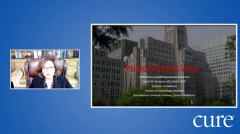
Educated Patient® MPN Summit Current Treatment Options in Polycythemia Vera Presentation: November 19, 2022
Watch Dr. Jamile M. Shammo, from Northwestern University Feinberg School of Medicine, discuss current treatment options in polycythemia vera during the CURE Educated Patient MPN Summit.
Episodes in this series

Patients diagnosed with polycythemia vera currently have more specialized treatment options that may lead to improved responses to therapy, an expert said.
Dr. Jamile M. Shammo, professor of medicine in the division of hematology oncology at Northwestern University Feinberg School of Medicine in Chicago, discussed the current treatment landscape of polycythemia vera at the CURE® Educated Patient® MPN Summit.
In particular, polycythemia vera is a rare blood cancer resulting in an excess of red blood cells leading to thicker, slow-moving blood that clots easily. In her presentation, Shammo discussed how clinicians can better identify polycythemia vera to make for more accurate diagnoses as well as how these patients can be treated more specifically to their disease and personal risk factors.
Diagnosing Polycythemia Vera
Currently, analyzing JAK2 gene is a large part of diagnosing polycythemia vera, as a mutation on this gene is a direct cause of the disease. Of note, approximately 95% of patients with polycythemia vera have this mutation, according to the presentation. Increasing production of red blood cells is a normal function of the immune system, and a standard JAK2 gene will end this process once the body’s need has been met.
When a patient has a mutated JAK2 gene, this process will not end and red blood cell production will “essentially leave those stem cells on overdrive … and it constantly transmits the signal to the nucleus for the production of not just red cells, but various types of blood elements,” Shammo said. This imbalance of blood elements produces polycythemia vera.
Other markers doctors can look for in lab tests include elevated hematocrit, hemoglobin, white cell/platelet counts as the aforementioned over-produced blood elements as well as serum uric acid, lactate dehydrogenase and vitamin B12 (a hallmark of myeloproliferative disease).
Patients may also have low levels of erythropoietin, a kidney hormone that stimulates red blood cell production, as the body attempts to correct the high red blood cell count on its own. Some may be iron deficient, negating the usual high hemoglobin counts associated with polycythemia vera, and potentially causing misdiagnosis.
Risk-Aware Treatment Options
Patients at risk of thrombosis — blood clots that block blood vessels — require an addendum to the standard disease treatment. All patients with polycythemia vera have this risk for thrombosis, as this is a potential result of the disease itself, but patients older than 60 years or have a history of thrombosis are at a higher risk.
All patients diagnosed with polycythemia vera may be treated with a low-dose aspirin and phlebotomy, or bloodletting, as the standard treatment course to manage their hematocrit measurement (volume percentage of red blood cells in blood). The goal for all patients is to reach a hematocrit level of less than 45% to reduce the risk for other treatment side effects.
Patients with polycythemia vera who are considered high risk will also require cytoreduction therapy, with a 12-week course of either hydroxyurea or interferon alpha. This works to keep blood cell counts low, as opposed to lowering them using phlebotomy. Roughly one quarter of patients become resistant or intolerant to treatment after this initial course.
A third option, Besremi (ropeginterferon alfa-2b), was approved by the Food and Drug Administration in November 2021 to treat polycythemia vera and showed increased response rates over time when compared with standard interferon alpha treatment.
A second-line treatment of JAK inhibitors (to manage the JAK2 mutation) or hepcidin mimetics (to regulate blood-iron levels and may eliminate the need for phlebotomy) may be prescribed for patients who are treatment resistant. These represent the most recent developments in treatment of polycythemia vera.
Shammo highlighted the importance of continued research and approvals for the treatment of patients with polycythemia vera. “I think we are all in favor of new agents,” she said.
For more news on cancer updates, research and education, don’t forget to














